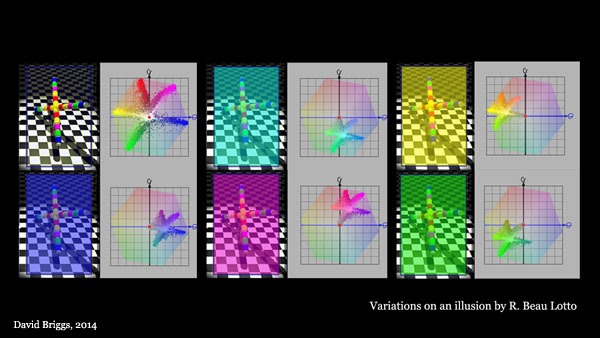my colour short course is
now offered online through
Australia's National Art
School in Sydney! There's
a choice of two sessions to
suit every time zone. LINK
Home
The Dimensions of Colour
Basics of Light and Shade
Basics of Colour Vision
Additive Mixing
Subtractive Mixing
Mixing of Paints
Hue
Lightness and Chroma
Brightness and Saturation
Principles of Colour
Afterthoughts
- Purves and Lotto
- Modern Colour Theory
- Traditional Colour Theory
- What is Color?
- Answers
- Colour Constancy Illusions
- Colour Quiz
- What is a Colour?
Colour Education
Color Impact 2020 - Colour Attributes
- Shillito portfolio
- Dimensions Today
- Index of Works
- Psychophysical
- Shillito Paper
- Elements of Colour
- Objects and Light
-
Glossary
References
Contact
Links
NEXT COLOUR
WORKSHOPS

11.4 "What is Color?"
This page presents an explanation of colour for school children, produced in response to the 2014 Flame Challenge by actor Alan Alda. Whether it succeeds with its target audience or not, I hope it helps promote a better understanding of colour, and especially of the significance of the opponent model of colour vision, which holds that colours are created by the eye and brain as combinations of red, yellow, green and blue colour signals.
After reading this page you may like to watch the video version I submitted, which can be viewed at the bottom of the page. For all image credits please see the video or its Vimeo page.
...
My nephews Jay and Guy have been using a glass prism to study the spectrum. Both saw a spectrum, but the colours that they saw were very different.

Isaac Newton observed that when white light passes through a glass prism, different rays of light are bent by different amounts, and these rays appear different colours. Newton called this coloured band of light a spectrum.

Newton also showed that mixing these coloured rays made white light again.
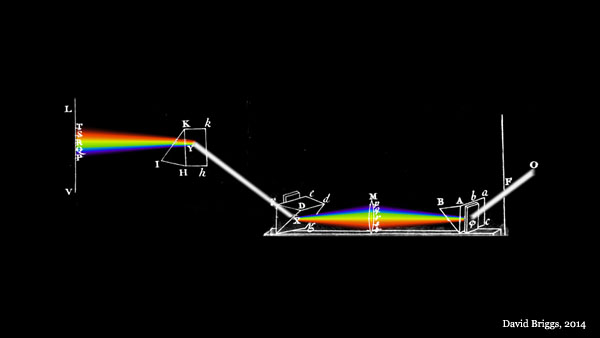
Today we think of these coloured rays as waves of different wavelength.
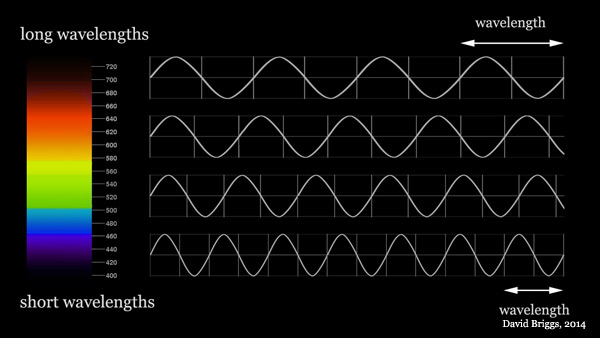
Newton also said something very strange: he said that "the rays to speak properly are not coloured". By this he meant that a colour is really a sensation of the mind resulting from light, just like a sound is a sensation of the mind resulting from physical vibrations of the air.

You may know that there are three primary colours for mixing paints. There are also three primary colours for mixing lights: red, green and blue.

Every colour you've ever seen on your computer screen, including white, is made by mixing lights of these three primary colours (drag the sliders at the bottom to adjust).
PLEASE STOP AND THINK ABOUT THIS QUESTION: If the spectrum is a continuous series of many wavelengths, why should three colours be special? Where does that number three come from?

AND THIS QUESTION: If the spectrum is just a series of short to long wavelengths, why do colours form a circle?

The key to both questions is that Newton was right when he said that the rays to speak properly are not coloured. The rays of the spectrum differ only in wavelength; our eyes and brain add the colours. And some of us add different colours to others.

The reason why primary colours come in sets of three is that human eyes have three types of light-detecting cells, called cone cells, used in seeing colour. L cones respond to all wavelengths, but respond most to those we see as yellow. M cones also respond to all wavelengths, but respond most to those we see as green. S cones respond most to wavelengths we see as blue and violet.
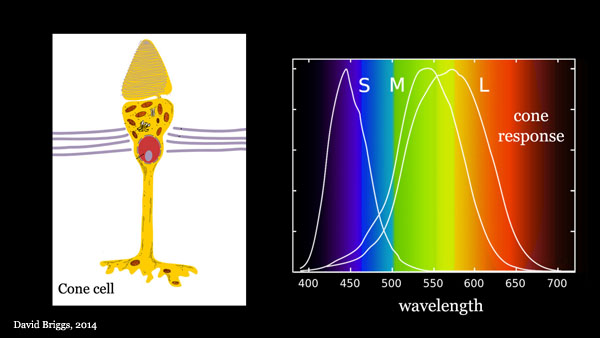
The three primary colours for mixing coloured lights each make one type of cone cell respond more than the other two. The three primary colours for mixing paints each absorb one of these light-mixing primaries. [To explain why this works is another story; if you are interested, you should look up subtractive colour mixing].
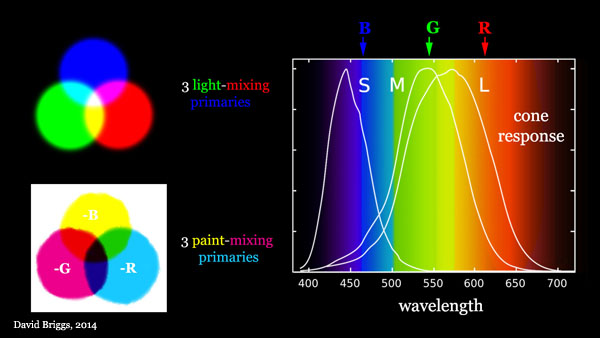
Notice carefully that no cone cell can "detect" any particular colour band of the spectrum, such as red or green. For example, when an L cone cell responds to light, it doesn't "know" if it's responding to a small amount of light from the yellow band, or a larger amount of light from some other band.
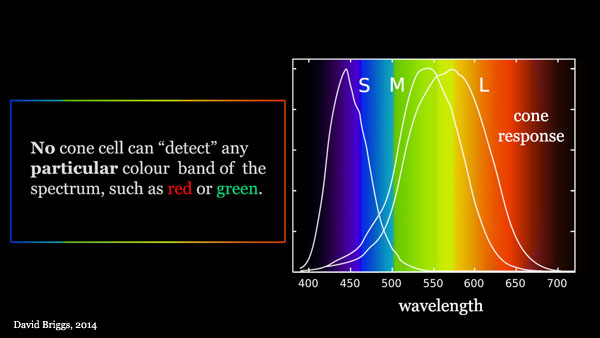
We tell wavelengths apart by comparing how our L, M and S cone cells respond. When we see an even range of wavelengths of light, our L, M and S cone cells all respond similarly, and we see the light as white.

But any single wavelength or band of the spectrum produces an unequal response of the L, M and S cone cells. Colours are signals that our eyes and brain create when we detect uneven amounts of the different wavelengths of light - by means of the unequal response of our cone cells.

Our eyes and brain create four basic colours, yellow, blue, red and green, arranged in two pairs.

One colour signal is either yellow or blue: We see yellow in the part of the spectrum where L and M respond most, and blue in the part where S does.The other colour signal is either red or green: We see red at the two ends of the spectrum, where L or S respond most, and green in the middle, where M does.

So the colour "red" is not something we "detect" in light, but is a signal added by the eye and brain to two parts of the spectrum that have nothing in common physically.

You might be wondering why our eyes and brain would do this, but look what we get when the two colour signals combine:
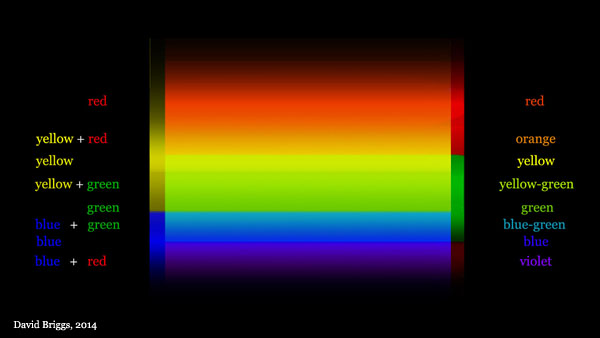
Colours form a circle because the combinations of the four colour signals we create form a continuous loop: RED + YELLOW, YELLOW + GREEN, GREEN + BLUE, BLUE + RED. Single wavelengths of the spectrum can produce most but not all of the possible combinations.
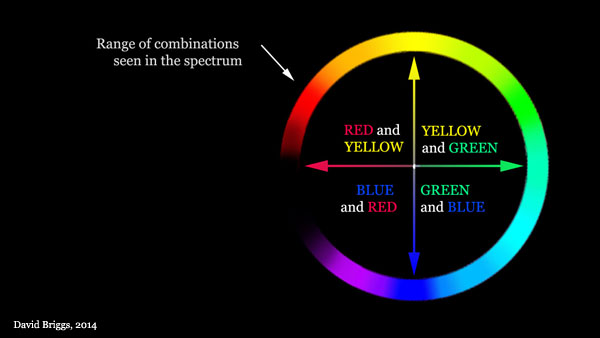
Magenta is a combination of our blue and red colour signals, produced exactly the same way as the colours of the spectrum, but from mixtures of wavelengths from the two ends.

My nephew Guy's eyes have only two types of cones1. So his brain can create a yellow/blue signal, but with no middle cone, no red/green signal, so his spectrum has only two colours.

You can actually see how much light of each wavelength an object reflects by shining a spectrum onto it. White and grey objects reflect all wavelengths of light about evenly, while coloured objects reflect the wavelengths of light unevenly.
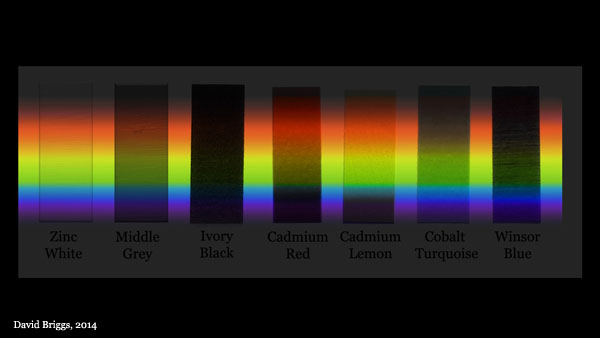
A bright yellow object like a lemon absorbs blue and violet wavelengths, and reflects red, orange, yellow and green wavelengths.Our L and M cones both respond strongly to these wavelengths, and these responses:
- combine to create a strong yellow colour signal, and
- cancel each other from making a strong red or green colour signal.
[Study this section again to see if you can work out why].

On your computer screen the colour of the lemon is made by tiny red and green lights.
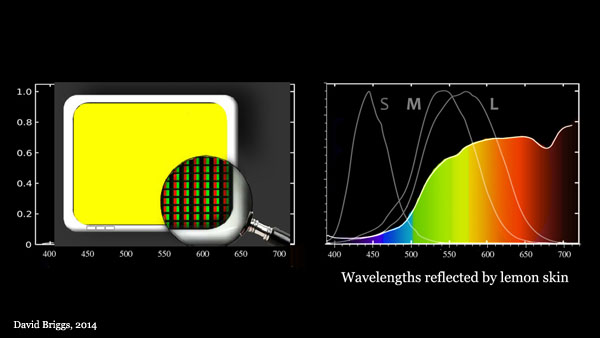
Together these give off wavelengths of a similar range to the lemon that create the same relative response of our cone cells, and so the same colour, even though the proportions of these wavelengths are very different.
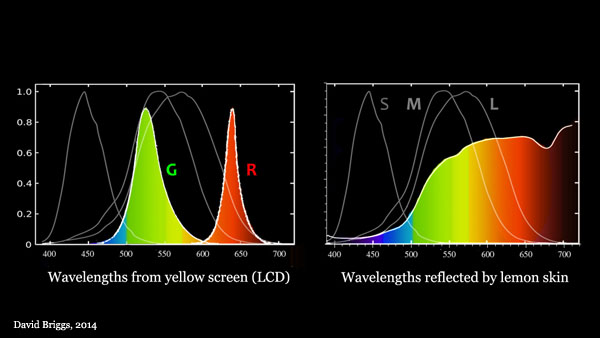
P.S. Colour is more complex in complex scenes. A white object can reflect light of any colour if the lighting is that colour. Our brains are quite good at automatically allowing for these effects of lighting, and because of this ability, called colour constancy, the colour that we see an object as being depends not just the wavelengths coming from it, but on the whole scene.

You probably see an object coloured like the one on the upper left in all of these pictures, even though each of the other five pictures actually contains a very small range of colours, from only about a third of the colour wheel!2 (click picture to enlarge).
If you study this explanation carefully you will understand much better than most adults what colour really is. But if you take the time to explain it to them, and they keep trying, you'll find they can eventually understand almost anything.
...
This is the video version submitted for the competition:
You can leave comments on the video on its Vimeo page:
David Briggs - What is Colour?
...
As a test of your understanding after studying this page and the video, you might like to watch these two YouTube videos to see if you can see the problems with them. (I've written a technical explanation of what I think is wrong with them here).
This Is Not Yellow (Michael Stevens, Vsauce)
https://www.youtube.com/watch?v=R3unPcJDbCc
Colour Mixing: The Mystery of Magenta (Steve Mould)
https://www.youtube.com/watch?v=iPPYGJjKVco

